Sports, which include a range of running, walking, jumping, and throwing competitions. In the United States, these competitions are referred to as track and field, or simply track, but in other countries, they are typically classified as athletics. This page discusses the administration, organisation, and history of sports, as well as the rules and strategies governing each individual event and some of the most well-known players in the history of the sport.
Since track and field athletics evolved from the most fundamental human activities—running, walking, jumping, and throwing—it is the oldest organised sport. With competitions held in almost every nation in the world, athletics has emerged as the most truly global sport.
What is sports in Athletics?
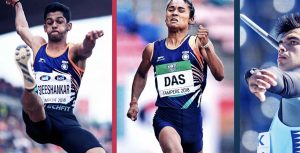
The majority of countries send men’s and women’s track and field teams to the official World Championships and the quadrennial Olympic Games. In addition, a number of continental and intercontinental championship events are conducted, such as the Asian, Pan-American, African, European, and Commonwealth.
Athletics is a broad term that encompasses up to twenty different events. A meet consists of these, usually outdoor, activities. Field events (throwing and jumping) take place either inside the track’s boundaries or in nearby locations, while outdoor running competitions take place on an oval track measuring 400 metres or 440 yards.
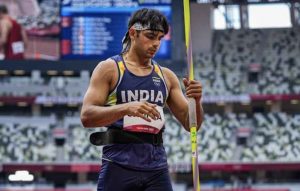
Different but related competitions that are not held on the track fall under the general umbrella of track and field athletics. Competitions for cross-country running are held in different kinds of parklands and rural areas.
Long-distance race walks are held on measured road courses, while marathons and other long-distance races are conducted on roadways. The International Association of Athletics Federations (IAAF) and its member bodies from every country set and implement the regulations that are adhered to by all organised competitions. All world records are also endorsed by the IAAF.
History and Origin:
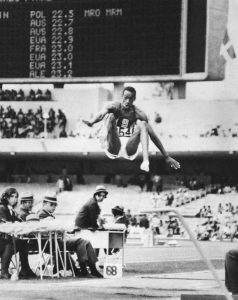
The early history of athletics as an organised sport is not well documented. Many centuries before the Christian era, athletics is known to have been promoted by Asian and Egyptian civilizations. Ireland hosted the Tailteann Games, a track and field competition, as early as 1829 BC as part of the Lugnasad festival.
Greece’s Olympic Games, which are said to have begun in 776 BC, lasted for eleven centuries until coming to an end in 393 AD. The ancient Olympics were exclusively open to men, both as competitors and spectators. It was said that Greek women organised their own Heraea Games, which took place every four years just like the Olympics.
The modern sport of athletics originated and developed in England. When practice fields were first built in London in 1154, the sport was first mentioned in England. King Edward III outlawed the sport in the 1300s, but Henry VIII—who was rumoured to be a skilled hammer thrower—revived it a century later.
Development and modernization:

However, the modern sport did not begin to develop until the early 1800s. Even though organised amateur footraces were held in England as early as 1825, athletics did not see its greatest upsurge until 1860. The first amateur meet was held in 1861 by the West London Rowing Club, and the first English championships were held in 1866 by the newly formed Amateur Athletic Club (AAC).
Competition for “gentlemen amateurs,” who were not paid, was the main focus of all these meets. In 1880, the Amateur Athletic Association (AAA) took over as the governing body, replacing the AAC.
Types of sports in Athletics:
1. Running:
The sprints:
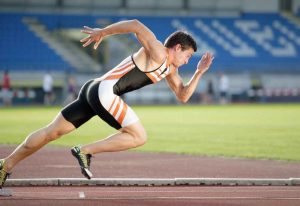
The 400-meter sprint distances, which are comparatively short, call for a steady top speed. Before the invention of the crouch in the 1880s, all sprinters had to begin from a standing position. As a result, it became mandatory for sprinters to begin with both feet and both hands on the track. The fast start, which is essential for sprints, was made easier with the introduction of the adjustable starting block.
The person who holds the current 100-meter record is typically referred to as “the fastest human.” Champions like Eddie Tolan, Jesse Owens, Bobby Morrow, Bob Hayes, and Carl Lewis (all from the United States), Valeriy Borzov (from the Soviet Union), Linford Christie (from the United Kingdom), and Donovan Bailey (from Canada) have all held that title.
At a meet in Athens, Greece in 1999, Maurice Greene of the United States set a record time of 9.79 seconds. Notable female sprint champions include East Germany’s Marita Koch, who won all three sprint distances, the Netherlands’ Fanny Blankers-Koen, who won four gold medals at the 1948 Olympics, the United States’ Wilma Rudolph, who won three in 1960, and the United States’ Florence Griffith Joyner, who set world records in the 100 and 200 metres in 1988.
The 400 metres is a lane-only event where the sprinters are spaced progressively farther up the track based on how far their lane is from the inside edge. The distance is equalised by a staggered start.
Three athletes stood out in this event: Michael Johnson (U.S.), who set a world record of 43.18 seconds at the 1999 World Championships in Sevilla, Spain; Alberto Juantorena (Cuba), whose 44.26-second time in the 1976 Olympics was the fastest without the use of high altitude; and Lee Evans (U.S.), whose 43.86-second mark remained the world record 20 years after he set it in 1968. At the 1983 World Championships, Jarmila Kratochvilova (Czechoslovakia) achieved a unique double victory in the women’s 400- and 800-meter events.
Middle-distance running:

More endurance is required for longer races. In this discussion, the middle-distance events span 800–2,000 metres. The 3,000-meter race is regarded as middle-distance by some officials.
Generally speaking, middle-distance runners can run well over shorter or longer distances. Pacing and other racing strategies are more crucial at these distances than they are at any other. The mile is still a glamorous event even though it is no longer a championship event. Roger Bannister of England, who ran a mile in under four minutes in 1954, made headlines around the globe.
Even though the world’s best runners now routinely achieve a “sub-four,” it is still a noteworthy time. Some notable middle-distance runners are Noureddine Morceli (Algeria), who won two world championships and an Olympic gold medal in the 1,500 metres; Sebastian Coe (United Kingdom), who won two gold and two silver medals in the 1,500 metres and the 5,000 metres on the same day in the 1924 Olympics; and Hicham El Guerrouj (Morocco), who set world records in both the 1,500 and the mile.
A pair of Soviet ladies produced noteworthy mid-distance records. Lyudmila Bragina set eight world records, and Tatyana Kazankina took home five. Additionally, American Mary Decker Slaney won frequently.
Long-distance running:
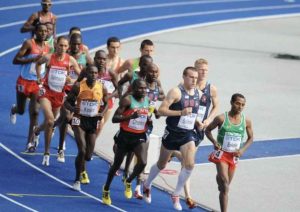
The distinction between long-distance and middle-distance running is a topic of debate. The marathon, steeplechase, cross-country, and road races are among the 3,000-meter-and-above long-distance competitions that are taken into consideration here. With longer runs, speed becomes even less significant; pace and endurance become more significant in its place. The “finishing kick,” or sudden surge of speed at the end of the race, is less likely the longer the run.
The long- and middle-distance races may also overlap with runners. In the 1,500 and 5,000 metres, Nurmi, Gunder Hägg (Sweden), and Said Aouita (Morocco) all set world records. All distances over 1,000 metres, with the exception of the marathon, were won by Nurmi.
The most frequent record-setters are distance runners, such as Nurmi, Emil Zátopek (Czechoslovakia), Ron Clarke (Australia), Kip Keino (Kenya), Haile Gebrselassie (Ethiopia), and Kip Keino (Kenya). The latter accomplished the amazing double by winning the 5,000- and 10,000-meter races at the 1952 Olympic Games. Women’s longer races have taken a while to take off, but some runners, like Ingrid Kristiansen of Norway, have been able to compete at different distances.
Long-distance running and hurdle jumping are combined in the steeplechase, where competitors must clear 28 hurdles and seven water jumps over a 3,000-meter course. The ability to run the distance is by far the most important requirement, even though hurdling is a significant part of the event.
Although most steeplechase competitors are experts, there are instances of fine-distance runners who have triumphed over more seasoned hurdlers. Among the best in the steeplechase, Henry Rono (Kenya) also held world records in the 3,000, 5,000, and 10,000 metres.
The marathon has grown to be a main attraction at the Olympics and other international competitions. It was a major event at the first modern Olympic Games in 1896. The race was initially held to honour the achievement of a Greek soldier who is said to have run from Marathon to Athens in 490 BC in order to report on the Greek victory against the Persians. The marathon is the longest race at the track meet, clocking in at 26.22 miles (42,186 metres). Two of the more notable marathoners are Zátopek and Finland’s Hannes Kolehmainen.
2. Hurdling:
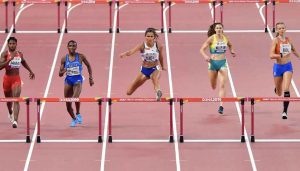
Hurdling events include both sprinting and navigating a course of obstacles known as hurdles. The 110-meter high hurdles are contested by men over ten barriers that are 9.14 metres (10 yards) apart and 106.7 cm (42 inches) high. Ten hurdles are covered in the 400-meter intermediate hurdles, but they are spaced 35 metres (38.29 yards) apart and measure 91.4 cm (36 inches) in height.
Both the 400-meter and 100-meter hurdle events are now run by women. A hurdler may clear as many hurdles as he pleases, but he will not be allowed to continue if he leaves his lane or clears hurdles with his hands. The goal is to avoid obstructing forward motion by making the hurdling action fluid and rhythmic.
As most champion hurdlers are also skilled sprinters, high hurdlers require exceptional speed. Harrison Dillard (U.S.), the 1948 Olympic 100-meter flat race winner and the 1952 Olympic high hurdles winner, is a prime example. Intermediate hurdlers are able to combine agility with speed.
World records were broken by American Glenn Davis (who competed in both the 1956 and 1960 Olympics) in both the flat and hurdle events. The event was essentially revolutionised by Edwin Moses (U.S.) with his unique 13-stride (between hurdles) technique. In addition, he won two Olympics and amassed a winning run of almost ten years.
3. Relays:
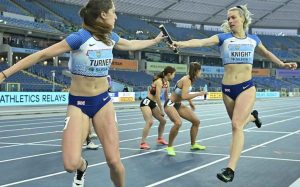
Teams of four runners compete in the relays; each runner carries a baton for 25% of the distance before handing it off to the following runner on the team. There are two standard events: the 4 × 100- and 4 × 400-meter relays. They are competing in the Olympic Games, the IAAF World Championships, and low-level dual meets.
In the shorter event, where each runner covers 100 metres, passing the baton well is especially important. Speed is vital in both events. There is suspense in the event when the baton is exchanged while travelling at a speed of roughly 25 miles per hour. The quality of baton passing has determined the outcome of many races.
4. Walking:

This is a relatively minor event that is also known as race walking. Track meets hardly ever include it, with the exception of international competitions like the Olympics. Individual competitions use different distances, but Olympic competition takes place over 20,000 and 50,000 metres.
5. Jumping:
The high jump:
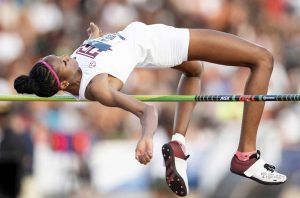
The jumper must take off from the ground with one foot, not two, according to the one fundamental rule of high jumping. The jumper stays in the competition as long as he avoids missing three straight times, and the goal is to clear a thin bar that is positioned between two standards.
As the bar is raised to new heights, jumpers are free to enter the competition at any height above the minimum and are permitted to pass any height. Sawdust and dirt landing pits have been replaced by inflatable or foam-rubber landing pits. Because jumpers frequently land on their necks and backs, the modern pits are valuable.
With the invention of the scissors, eastern cut-off, western roll, and straddle (also known as the belly roll), jumping styles developed in the 20th century before the Fosbury flop. The flop, named for its inventor, American Olympic champion Dick Fosbury (1968), entails approaching from nearly straight ahead, twisting on takeoff, and landing headfirst with the back to the bar.
In 1956, Charles Dumas, a well-known straddle jumper from the United States, cleared 7 feet (2.13 metres) and became the first man to do so. Using the straddle jump, Valeriy Brumel (U.S.S.R.) held the high-jump record for ten years. Iolanda Balas, a Romanian woman jumper, accomplished incredible feats in the sport, setting 13 world records and winning 140 meets in a row.
The pole vault:
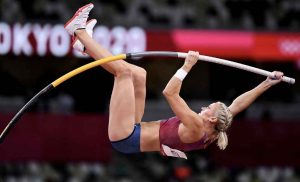
Similar to high jumping, pole vaulting involves competitors trying to vault over a crossbar set atop uprights, with three attempts allowed for each height, and landing in an inflated or composition pit.
With a pole in hand, the vaulter sprints approximately 45 metres (150 feet) down a runway. The vaulter lifts himself off the ground and nearly performs a handstand on the pole after inserting the pole’s end into a box that is submerged beneath the surface. When he gets close to the crossbar, he twists and crosses it facedown, feet first.
The initial poles were unwieldy and heavy, made of solid ash, cedar, or hickory. The bamboo pole gained popularity very quickly after it was introduced in 1904. Bamboo records were used until 1957 when steel and aluminium records were used instead. In the 1960s, fibreglass records replaced these metal records.
Cornelius Warmerdam (U.S.) was the dominant vaulter of the bamboo era, holding six world records. He was the first vaulter to reach over 15 feet (4.6 metres) and set a record of 15 feet 7.75 inches that stood for 15 years.
Fibreglass pole technology has advanced continuously, enabling vaulters like Sergey Bubka (Ukraine) to break the record by more than 20 feet in the 1990s. The women’s pole vault event was introduced to the IAAF competition schedule in the 1990s, and the first female world and Olympic champion was American Stacy Dragila.
The long jump:
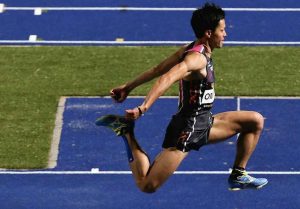
The simplest field event is long jumping, formerly known as broad jumping. The most important component for a successful jump is speed. Approaching at almost maximum velocity, jumpers place one foot on the takeoff board and launch themselves into the air. No portion of the forward foot may protrude past the board for a jump to be considered lawful. The “hitch-kick” is the most well-liked long-jumping technique, where the runner appears to be walking in midair.
When it comes to the history of long jumping, three notable locations stand out. The first of these was the feat accomplished by American Jesse Owens on May 25, 1935, when he leapt 8.13 metres (26 feet 8.25 inches), setting a record that stood for 25 years.
The second was a leap of 8.90 metres (29 feet 2.5 inches) by American Bob Beamon, which beat the previous world record by 55 centimetres (21.5 inches). In 1991, Mike Powell of the United States achieved a third feat by surpassing Beamon’s 23-year record with a jump of 8.95 metres (29 feet 4.5 inches).
Heike Drechsler from Germany and Jackie Joyner-Kersee from the United States are two notable female jumpers who each jumped over 7 metres (23 feet).
The triple jump:
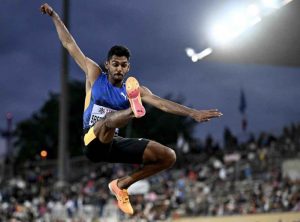
The triple jump, formerly called the hop, step, and jump, consists of three separate action segments. The jumper, who is a little slower than long jumpers, has a similar style as they come down the runway and leap off a takeoff board. In the first part, the jumper hops, landing on the same foot that he used to take off. He then steps, landing on the opposite foot, and jumps into the sand pit to finish.
Among the notable competitors were Adhemar da Silva (Brazil), who won two Olympics and set five world records; Jozef Schmidt (Poland), who was also a two-time Olympic champion and the first person to cross the 17-meter mark with a record of 17.03 metres (55 feet 10.5 inches); and Viktor Saneyev (U.S.S.R.), who set three world records, won three Olympics, and finished in second place. In the middle of the 1980s, women started competing in the triple jump.
Throwing:
The four traditional throwing competitions—shot, discus, hammer, and javelin—all require the use of long-distance thrown objects of varied weights and forms.
The shot put:
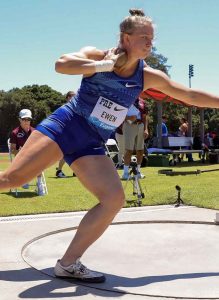
Because the arm cannot extend behind the shoulders during the putting action per the rules, the putting action is best described as shoving the shot. The metal that makes up the spherical shot. The men’s shot has a diameter of 110–130 mm (4.3–5.1 inches) and weighs 7.26 kg (16 pounds). A 4-kg (8.82-pound) shot with a diameter of 95–110 mm (3.7–4.3 inches) is injected by women.
The putter needs to gather momentum for the put by quickly twisting, as they must launch the shot from inside a ring that is 2.135 metres (7 feet) in diameter. Among the biggest athletes in track and field are shot putters, with the most powerful throwing athletes weighing between 250 and 300 pounds (113 and 136 kg).
Weight training started to take centre stage in shot-putter training regimens in the 1950s. During that same time, the O’Brien putting style gained popularity and achieved remarkable success. The style was created by American Parry O’Brien and involved a 180-degree turn across the ring as opposed to the customary 90-degree turn. This gave the action more speed and momentum.
With three gold medals from the Olympics and a record-breaking jump of 19.30 metres (63 feet 4 inches) above the previous 17.95 metres (58 feet 10.75 inches), O’Brien was the greatest practitioner of the style.
A technique developed by American Brian Oldfield, it involves the putter spinning 1.5 turns before releasing the shot, which has gained popularity among certain athletes.
The discus throw:
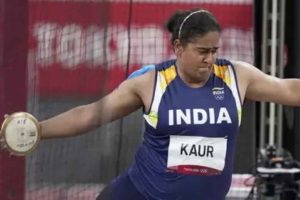
Given that discus throwing was mentioned by the Greek poet Homer in the eighth century BC, discus throwing is regarded by many as the quintessential athletic event. A 2-kg (4.4-pound) plate-like object is thrown by modern male athletes from a 2.5-meter (8.2-foot) circle. After the thrower has made one and a half turns, starting from the back of the circle, the discus is launched. The discus for women weighs one kilogramme (2.2 pounds).
The hammer throw:

The tool used in the hammer throw is not a traditional hammer, but rather a metal ball with a diameter of at least 110 mm (4.3 inches) that is fastened to a wire. The entire tool is at least 1,175 mm (46.3 inches) long and weighs at least 7.2 kg (16 pounds).
The thrower grasps the handle at the end of the wire opposite the ball and releases it once the maximum centrifugal force has been developed through three or four body turns. Comparing the throwing circle to the discus, it is marginally smaller. In the 1990s, women’s hammer throw was added to the international competition schedule. Women typically use a hammer that is at least 4 kg (8.8 pounds) in weight and is slightly shorter.
From the 1890s through the 1930s, American athletes of Irish ancestry completely dominated the competition. Among them was John Flanagan, who captured three Olympic gold medals (1900, 1904, and 1908) and unofficially set seventeen world records.
Eastern Europeans came to hold more power after the Irish dynasty fell. Among them was Yury Sedykh (U.S.S.R.), who improved the record from 80.32 metres (24.5 feet) to 86.74 metres (26.4 feet) after winning in the Olympics in 1976 and 1980.
The javelin throw:
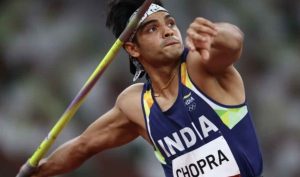
At the end of an approach run, a spear-like object is thrown with an over-the-shoulder motion in javelin throwing. It is directly descended from spear-throwing competitions, which were first held at the 708 BC Olympics. The men’s javelin has a minimum length of 260 cm (8.5 feet) and weighs approximately 800 grammes (1.8 pounds).
The women throw a javelin that needs to be at least 220 cm (7.2 feet) long and 600 grams (1.3 pounds) in weight. This throwing competition is the only one without a circle. For a throw to be considered legitimate, the javelin must land point-first but not necessarily stick.
Finland’s throwers have always been strong competitors in the competition. Finn Matti Järvinen broke ten world records and eventually reached 77.23 metres (253 feet 4.5 inches) in 1936, improving the record by 6.22 metres. There was not as much room in the stadium to safely throw the javelin as records kept being broken.
In 1964, Terje Pedersen from Norway broke the 300-foot (91.44-meter) barrier. In 1984, Uwe Hohn from East Germany threw a phenomenal 104.80 metres (343.8 feet), which was so high that it changed the javelin’s design to keep it inside the field’s safe boundaries.
Decathlon and heptathlon:
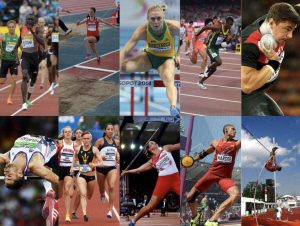
Men and women compete in multi-event events: the women in the 7-event heptathlon, which replaced the earlier pentathlon, and the men in the 10-event decathlon. The competitions, which call for a two-day schedule, primarily take place at national championships and international meets. They are also scheduled for numerous college conference championships in the United States.
Every athlete receives points based on how well they perform in each event; higher scores translate into more points. Athletes compete and win based on total points earned.
Each day, men compete in five different events: on the first day, they compete in the 100-meter hurdles, long jump, shot put, high jump, and 400 metres; on the second day, they compete in the 110-meter hurdles, discus throw, pole vault, javelin throw, and 1,500-meter run, in that order. On the first day, women compete in the 200-meter shot put, high jump, and 100-meter hurdles. On the second day, they compete in the long jump, javelin throw, and 800-meter sprint.
The first decathlon was won by the legendary American all-around athlete Jim Thorpe in the 1912 Olympic Games, and for a long while afterwards, it was primarily an American competition. In 1948, at the age of seventeen, Bob Mathias (U.S.) won his first decathlon and then did it again four years later. Daley Thompson of England was another two-time champion, having won in 1980 and 1984. Jackie Joyner-Kersee, who set records and won the 1988 Olympics and the 1987 World Championships, was notable in the heptathlon.
So, this was all about the sports in Athletics. Also read, Top 10 oldest sports in the world – History unveils!

